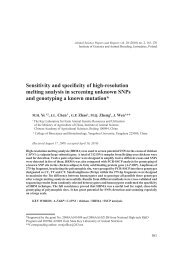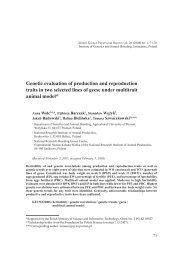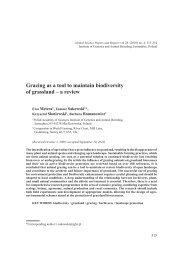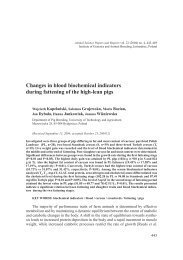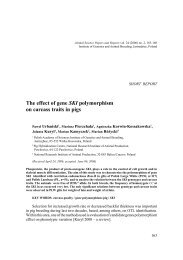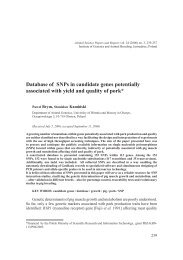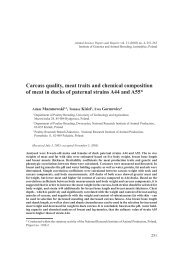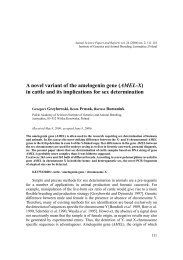Hoof size as related to body size in the horse (Equus caballus)
Hoof size as related to body size in the horse (Equus caballus)
Hoof size as related to body size in the horse (Equus caballus)
You also want an ePaper? Increase the reach of your titles
YUMPU automatically turns print PDFs into web optimized ePapers that Google loves.
A. Stachurska et al.<br />
214<br />
KEY WORDS: <strong>body</strong> dimensions / fore hoof / hoof dimensions / <strong>horse</strong> <strong>size</strong><br />
The hoof <strong>size</strong> is <strong>in</strong>fluenced, apart from genetic fac<strong>to</strong>rs, by many environmental<br />
effects, of which nutrition is <strong>the</strong> most important. It h<strong>as</strong> been documented that weanl<strong>in</strong>gs<br />
fed ad libitum with balanced ration had bigger hoof sole border than those which had<br />
limited access <strong>to</strong> <strong>the</strong> same feed [Butler and H<strong>in</strong>tz 1977]. Heritability coefficient of hoof<br />
conformation traits ranges from 0.16 for heel height <strong>to</strong> 0.27 for hoof shape [Ducro et<br />
al. 2009a]. Normal function<strong>in</strong>g of <strong>the</strong> hoof depends <strong>to</strong> a large degree on its <strong>size</strong>. The<br />
hoof should be a strong support for <strong>the</strong> <strong>horse</strong>’s <strong>body</strong> m<strong>as</strong>s. Thanks <strong>to</strong> <strong>the</strong> concave<br />
sole, wedge-shaped frog and <strong>the</strong> sharp-angled <strong>to</strong>e, it reduces slipp<strong>in</strong>g. The hard hoof<br />
capsule protects soft <strong>in</strong>ner structures. Concussion forces occurr<strong>in</strong>g dur<strong>in</strong>g movement,<br />
particularly high <strong>in</strong> f<strong>as</strong>t gaits and jumps on hard surface, are reduced by <strong>the</strong> el<strong>as</strong>tic<br />
structures <strong>in</strong> <strong>the</strong> hoof. A <strong>to</strong>o small hoof is not able <strong>to</strong> fulfill <strong>the</strong>se functions effectively<br />
and contributes <strong>to</strong> foot lameness [Redden 1997]. The rider considerably <strong>in</strong>cre<strong>as</strong>es <strong>the</strong><br />
natural fore hoof stra<strong>in</strong> and concussion <strong>in</strong> <strong>the</strong> movement [Clay<strong>to</strong>n 1997, Summerly<br />
et al. 1998, Clay<strong>to</strong>n et al. 1999]. Draught use of <strong>the</strong> <strong>horse</strong> additionally loads <strong>the</strong><br />
hooves, <strong>as</strong> well. The relation between <strong>the</strong> foot conformation and sport performance or<br />
movement traits is po<strong>in</strong>ted out <strong>in</strong> <strong>the</strong> recent publications by Ducro et al. [2009 ab] and<br />
van Heel et al. [2010]. However, <strong>the</strong> importance of <strong>the</strong> <strong>size</strong> of <strong>the</strong> hoof h<strong>as</strong> not been<br />
<strong>in</strong>vestigated extensively.<br />
Despite all <strong>the</strong> arguments for big hooves, <strong>in</strong> some breeds <strong>the</strong>y were once considered<br />
<strong>as</strong> <strong>in</strong>correct. Accord<strong>in</strong>g <strong>to</strong> Butler [1995], some American breeds were even selected<br />
for small feet for aes<strong>the</strong>tic re<strong>as</strong>ons. On <strong>the</strong> o<strong>the</strong>r hand, <strong>in</strong> many breeds <strong>the</strong> hoof <strong>size</strong><br />
is not <strong>the</strong> official selection criterion (e.g. <strong>in</strong> Poland) and that is <strong>the</strong> re<strong>as</strong>on for which<br />
<strong>the</strong> small hooves appear more frequently <strong>in</strong> <strong>the</strong> population. Instead, <strong>in</strong> show <strong>horse</strong><br />
breeds <strong>the</strong>re is a tendency <strong>to</strong> leng<strong>the</strong>n <strong>the</strong> hooves <strong>to</strong> achieve fl<strong>as</strong>hy gaits. It h<strong>as</strong> been<br />
documented that leng<strong>the</strong>n<strong>in</strong>g of <strong>the</strong> hoof <strong>in</strong>cre<strong>as</strong>es <strong>the</strong> maximum height of <strong>the</strong> hoof <strong>in</strong><br />
<strong>the</strong> flight, <strong>in</strong>cre<strong>as</strong>es <strong>the</strong> vertical velocity of <strong>the</strong> hoof and delays <strong>the</strong> breakover [Balch<br />
et al. 1994]. Some breed and show <strong>as</strong>sociations specify <strong>the</strong> maximum hoof length<br />
(me<strong>as</strong>ured on <strong>the</strong> dorsum of <strong>the</strong> front wall) with regard <strong>to</strong> <strong>the</strong> <strong>horse</strong> <strong>body</strong> weight <strong>to</strong><br />
prevent <strong>horse</strong> abuse [Lessiter 1996]. However, it does not concern <strong>the</strong> natural <strong>size</strong> of<br />
<strong>the</strong> capsule but <strong>the</strong> method of trimm<strong>in</strong>g.<br />
Apart from <strong>the</strong> length, <strong>the</strong> hoof <strong>size</strong> is usually judged subjectively. There is no<br />
commonly <strong>as</strong>sumed parameter which would show univocally whe<strong>the</strong>r <strong>the</strong> hoof is big<br />
or small relative <strong>to</strong> <strong>the</strong> <strong>horse</strong>’s <strong>size</strong>. It is necessary <strong>to</strong> po<strong>in</strong>t which hoof is considered<br />
s<strong>in</strong>ce <strong>in</strong> spite of high correlation between <strong>the</strong> fore and rear hoof dimensions, differences<br />
<strong>related</strong> <strong>to</strong> specific functions of fore and h<strong>in</strong>d limbs are known [Back et al. 1995,<br />
Gustĺs et al. 2004]. The hoof absolute <strong>size</strong> is me<strong>as</strong>ured <strong>in</strong> various ways. The width<br />
is <strong>the</strong> most characteristic hoof dimension with respect <strong>to</strong> <strong>the</strong> breed [Stachurska et al.<br />
2008]. The <strong>horse</strong> <strong>body</strong> <strong>size</strong> may also be specified <strong>in</strong> various parameters. The <strong>body</strong><br />
weight seems <strong>to</strong> be <strong>the</strong> most convenient, but not very useful because of limited access<br />
<strong>to</strong> <strong>the</strong> animal scale. Estimat<strong>in</strong>g <strong>the</strong> <strong>horse</strong> <strong>body</strong> weight with a tape is not accurate s<strong>in</strong>ce<br />
<strong>horse</strong> types and breeds are widely differentiated. For <strong>in</strong>stance, chest circumference



